|
Visual Anomaly Detection with FOMO-AD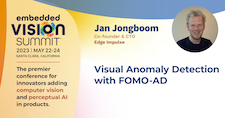
Virtually all computer vision machine learning models involve classification—for example, “how many humans are in the frame?” To train such a model, you need examples of every class of object the model is intended to detect. But what happens when a new type of object appears? Ask a model trained only on elephants and zebras to classify a giraffe and it will happily misclassify the image. Similarly, when you train a model to detect flaws (such as a broken bottle) on a production line, you need training data for every possible fault, which is impractical. The solution to this dilemma, as Jan Jongboom, Co-Founder and CTO of Edge Impulse, explains in this presentation, is FOMO-AD, an ML model for visual anomaly detection. FOMO-AD can be used along with classification models, in which case it flags instances where you shouldn’t trust the classifier (e.g., this animal is unlike anything I’ve ever seen), or it can be used standalone to detect anomalies without requiring the developer to define any explicit fault states.
Bring Your Machine Learning Models to the Edge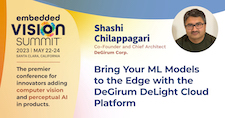
In this talk, Shashi Chilappagari, Co-Founder and Chief Architect of DeGirum, presents an overview of the DeLight Cloud Platform, which accelerates the edge AI application development process by bringing together application software, machine learning models and AI accelerator hardware. The platform provides cloud access to multiple AI hardware accelerators, including DeGirum’s ORCA, allowing developers to get started without investing time and money on bringing up hardware. It provides intuitive, hardware-agnostic APIs that enable developing a single software stack for multiple hardware options. Along with a rich model zoo covering a wide variety of applications, the platform provides tools to enable developers to port their own models. Chilappagari highlights the challenges in model porting, including proper specification of pre-processing and post-processing logic; targeting the model for multiple hardware; and pipelining various stages in the application to optimize performance. He illustrates, with the help of examples, how the DeLight platform overcomes these challenges.
|
|
Enabling Sensor Fusion for Robust Perception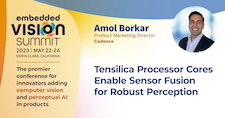
Until recently, the majority of sensor-based AI processing used vision and speech inputs. Recently, we have begun to see radar, LiDAR, event-based image sensors and other types of sensors used in new AI applications. And, increasingly, system developers are incorporating multiple, heterogeneous sensors in their designs and utilizing sensor fusion techniques to enable more robust machine perception. In this presentation, Amol Borkar, Product Marketing Director at Cadence, explores some of the heterogeneous sensor combinations and sensor fusion approaches that are gaining adoption in applications such as driver assistance and mobile robots. He also shows how the Cadence Tensilica ConnX and Vision processor IP core families and their associated software tools and libraries support sensor fusion applications with high performance, efficiency and ease of development.
Challenges in Architecting Vision Inference Systems for Transformer Models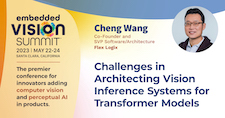
When used correctly, transformer neural networks can deliver greater accuracy for less computation. But transformers are challenging for existing AI engine architectures because they use many compute functions not required by previously prevalent convolutional neural networks. In this talk, Cheng Wang, Co-founder and CTO of Flex Logix, explores key transformer compute requirements and highlights how they differ from CNN compute requirements. He then introduces Flex Logix’s silicon IP InferX X1 AI accelerator. Wang shows how the dynamic TPU array architecture used by InferX efficiently executes transformer neural networks. He also explains how InferX integrates into your system and shows how it scales to adapt to varying cost and performance requirements.
|
|
Synopsys ARC NPX6 NPU IP (Best Edge AI Processor)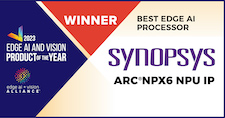
Synopsys’ ARC NPX6 NPU IP is the 2023 Edge AI and Vision Product of the Year Award winner in the Edge AI Processors category. The ARC NPX6 NPU IP is an AI inference engine optimized for the latest neural network models – including newly emerging transformers – which can scale from 8 to 3,500 TOPS to meet the demands of AI applications requiring real-time compute with ultra-low power consumption for consumer and safety-critical automotive applications. Key innovations of the NPX6 NPU IP start with a highly optimized 4K MAC building block with enhanced utilization, new sparsity features and hardware support for transformer networks. The (optional) integrated floating-point data types (FP16/BF16) are embedded in the existing 8-bit data paths to minimize area increase and maximize software flexibility. Scaling is accomplished with an innovative interconnect supporting scales of up to 24 4K MAC cores for 96K MAC (440 TOPS with sparsity) single-engine performance. Up to eight engines can be combined to achieve up to 3,500 TOPS performance on a single SoC. The NPX6 also expands on the ISO 26262 functional safety features of its predecessor, the EV7x vision processor. Both the NPU IP and the new ARC MetaWare MX Development Toolkit integrate connectivity features that enable implementation of multiple NPU instances to achieve up to 3,500 TOPS performance on a single SoC.
Please see here for more information on Synopsys’ ARC NPX6 NPU IP. The Edge AI and Vision Product of the Year Awards celebrate the innovation of the industry’s leading companies that are developing and enabling the next generation of edge AI and computer vision products. Winning a Product of the Year award recognizes a company’s leadership in edge AI and computer vision as evaluated by independent industry experts. |







